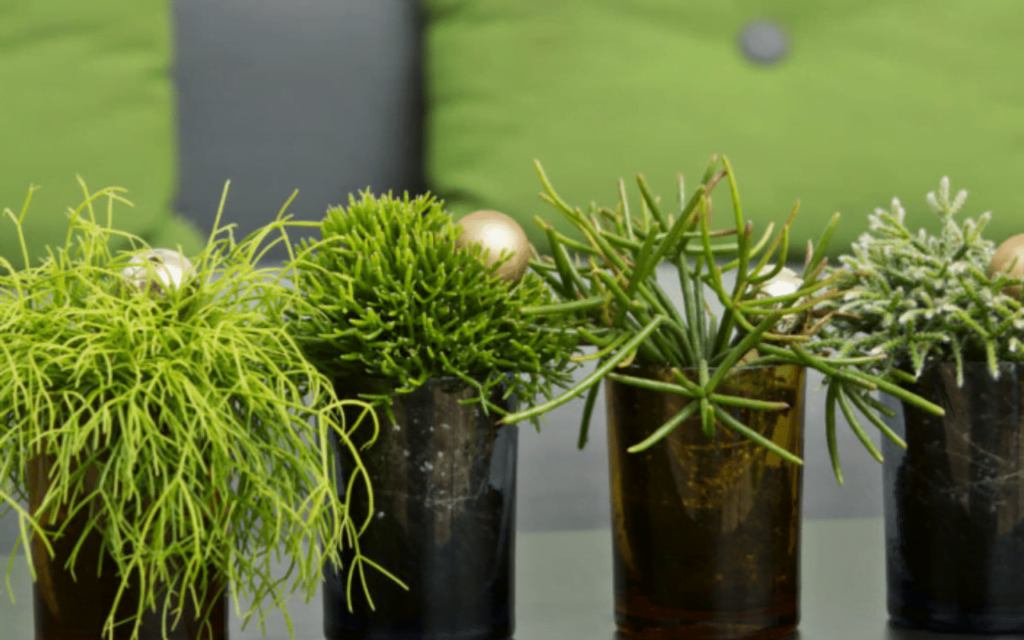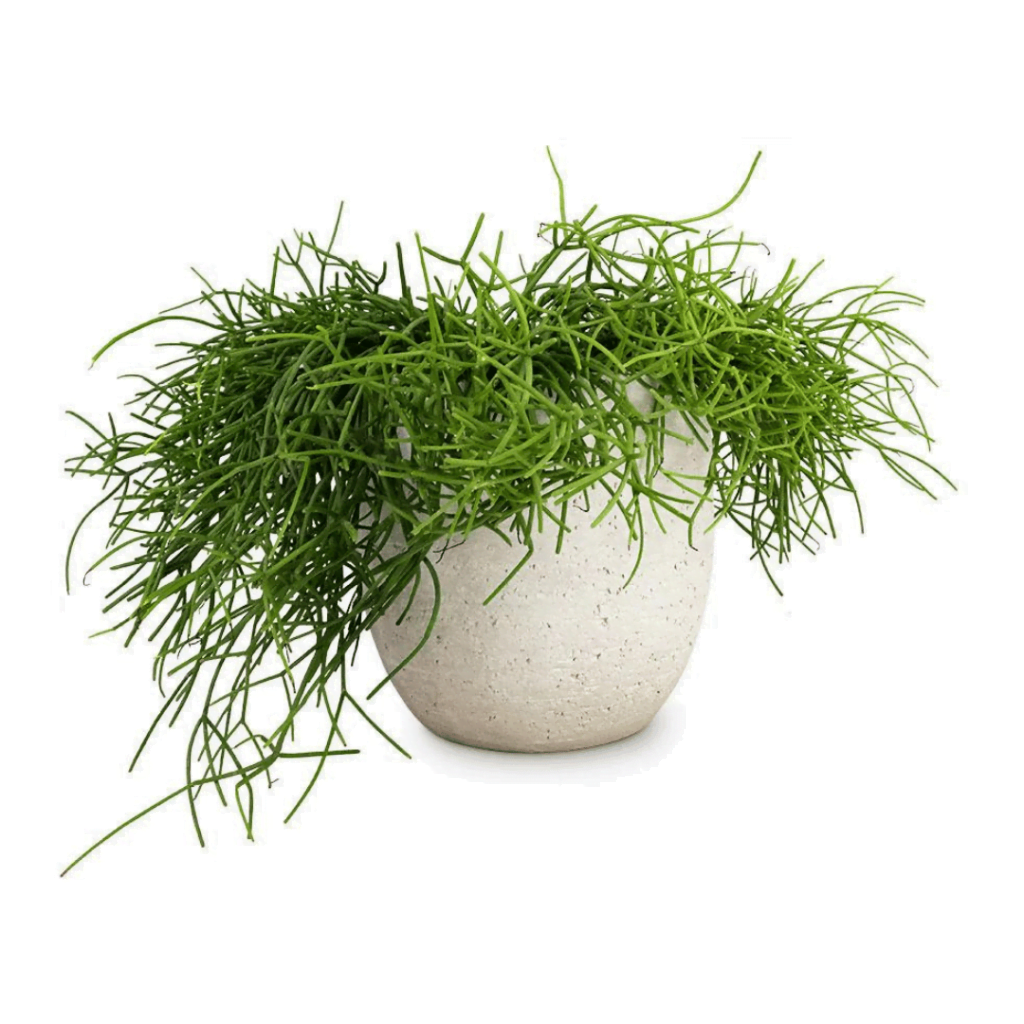Introduction
Indoor plants have forever been a part of human living spaces, adding beauty, freshness, and often a calming presence. Among the many indoor plants, the Rhipsalis, commonly known as the Mistletoe Cactus, stands out for its unique aesthetics and minimal care requirements. In this detailed review, we will delve into the various aspects of taking care of this elegant cactus and ensure it thrives in your space.
Rhipsalis (Mistletoe Cactus) Indoor Plant Details
| Specification | Details |
|---|---|
| Common Names | Mistletoe Cactus |
| Botanical Name | Rhipsalis baccifera |
| Family | Cactaceae |
| Plant Type | Epiphytic or lithophytic cactus |
| Mature Size | Up to 10 feet in length, though it typically hangs down |
| Sun Exposure | Prefers bright, indirect light. Avoid direct sunlight as it can cause stem discoloration |
| Soil Type | Well-draining cactus mix or succulent mix. Can be enhanced with sand or perlite. |
| Soil pH | Slightly acidic to neutral (6.0 to 7.5) |
| Bloom Time | Typically in late winter to spring, though it can vary |
| Flower Color | Small, white to pale yellow flowers |
| Hardiness Zones | 9b to 11. Preferably grown indoors in cooler climates |
| Native Area | Rainforests of Central and South America, the Caribbean, and Central Africa |
| Benefit | Apart from its aesthetic appeal, Rhipsalis purifies the air and increases humidity. |
This table provides a quick, comprehensive overview of the key specifications for Rhipsalis, also known as the Mistletoe Cactus. Such structured details help in easy understanding and reference, especially when one is planning to add this fascinating plant to their collection.
Plant Care
The care for Rhipsalis might seem intricate initially, but once understood, it’s a breeze. Its tropical origin has equipped it to survive in a variety of conditions. The trick lies in understanding its basic needs and ensuring they are met.
Light
This cactus loves light but not direct sunlight. A bright, indirect light source works wonders. East or north-facing windows are ideal. In too much direct sun, the stems might become discolored. If you notice a pale or white discoloration, it might be time to shift your plant to a shadier spot.
Soil
Rhipsalis prefers well-draining soil. A standard cactus mix does the trick. However, to give it an extra boost, consider adding some perlite or sand to the mix. This ensures that the soil doesn’t retain excessive moisture, which can lead to root rot.
Water
Overwatering is a common mistake many plant enthusiasts make. Rhipsalis needs to be watered when the top inch of the soil feels dry to the touch. Water it thoroughly, allowing excess water to drain out. In the dormant winter season, you can reduce the watering frequency.
Temperature and Humidity
Being a tropical plant, the Mistletoe Cactus thrives in warmer temperatures. The ideal range lies between 50°F to 80°F. While it can tolerate minor temperature drops, frost is its nemesis. It’s crucial to keep it away from drafts or windows that might let in cold air during winters. Humidity-wise, it’s pretty adaptable but will appreciate a misting during drier months.
Fertilizer
For optimal growth, feed your Rhipsalis with a diluted half-strength cactus fertilizer once a month during the growing season. Avoid feeding during the dormant winter months as the plant is in a resting phase.
Pruning
Regular pruning keeps the plant healthy and bushy. Snip off any discolored or shriveled stems. This not only enhances its appearance but also prevents any potential diseases.
Overwintering
While Rhipsalis can tolerate cooler temperatures, it’s essential to protect it from frost. If you have it outside during summer, make sure to bring it in before the temperatures drop. During winter, reduce watering and avoid fertilizing.
Propagating Plant
This plant can be easily propagated using stem cuttings. Cut a healthy stem and let it dry for a day or two. Then, plant it in well-draining soil. With proper care, you’ll have a new plant in no time!
Types of Rhipsalis Plant
There are over 35 species of Rhipsalis, each with its distinct appearance and care requirements. Some popular types include:
- Rhipsalis baccifera (Mistletoe cactus): Recognizable for its long, thin stems and small white flowers.
- Rhipsalis pilocarpa: This variety has fuzzy stems and produces fragrant white flowers.
- Rhipsalis cassutha: Known for its cascading, hair-like stems, it’s perfect for hanging baskets.
- Rhipsalis paradoxa: Distinct for its chain-like appearance, it’s a unique addition to any collection.
Common Pests & Plant Diseases with Solutions
Like any other indoor plant, Rhipsalis can be prone to certain pests and diseases. Here are common ones and how to deal with them:
- Mealybugs: These tiny, white pests suck on the plant’s juices. To combat them, wipe your plant with a cloth dipped in alcohol or use insecticidal soap.
- Scale: These are small, brown, shield-like bugs. Remove them manually and treat the plant with neem oil or insecticidal soap.
- Root rot: Overwatering can lead to this fungal disease. Ensure proper drainage and let the soil dry out between waterings. If infected, repot your plant into fresh, dry soil and trim off any affected roots.
How to Get Rhipsalis to Bloom
Rhipsalis blooms are a sight to behold. To encourage blooming:
- Light: Ensure they receive ample indirect light.
- Feeding: Use a balanced fertilizer during the growing season.
- Stress: A slight drop in temperature (not below 50°F) during the night can stimulate the plant to bloom.
Common Problems with Rhipsalis
- Yellowing or Whitening stems: Usually a sign of too much sunlight. Move the plant to a location with indirect light.
- Shriveled stems: Indicates underwatering. Increase your watering frequency.
- Mushy stems: A sign of overwatering. Allow the soil to dry out before watering again and ensure the pot has proper drainage.
- Sparse growth: This can be due to inadequate light or insufficient nutrients. Move the plant closer to a light source and consider feeding it with a balanced fertilizer.
Rhipsalis is a versatile and relatively low-maintenance plant. However, understanding its needs and common problems will ensure you enjoy its beauty for years to come. Whether you’re a novice or a seasoned plant enthusiast, this elegant cactus is a wonderful addition to any indoor garden.
Quickly Declining
If your Rhipsalis is declining quickly, it might be due to overwatering, pest infestations, or exposure to extreme temperatures. Always ensure the plant’s basic needs are met and regularly inspect for any issues.
Culminating Thoughts
Rhipsalis, with its cascading stems and easy-going nature, is a boon for both novice and experienced plant lovers. Proper care ensures it remains an evergreen addition to your space. Embrace this tropical beauty and let it enrich your interiors with its unique charm.
Frequently Asked Questions
Decode the magic of gardens with our guide to Landscaping Styles Frequently Asked Questions.
- Rhipsalis is generally considered non-toxic for both cats and dogs. However, always monitor your pets around plants to avoid any unwanted incidents.
- Repotting every 2-3 years is ideal, allowing the plant to have fresh soil and more space.
- Yellowing stems can be an indication of overwatering or excessive sunlight. Check the soil moisture and consider relocating the plant.
- In warmer climates, Rhipsalis can be grown outdoors as long as it’s protected from direct sunlight and frost.
Recent Posts
- Modern Mural Ideas Transforming Walls into Artworks
- Thematic Table Decor Dressing Your Table for Special Occasions
- Festive Lighting Ideas Brightening Your Home for the Holidays
- Biodegradable Decor Materials Choosing Earth-Friendly Options
- Personalized Space Decor Making Your Home Uniquely Yours
- New Year’s Eve Decor Ringing in the New Year in Style
- Transforming Junk into Decor Upcycling at Its Best
- Second-Life Decor Objects Giving Old Items New Purpose
- Unique Decoration Crafting Standout Ideas for Your Home
- Environmentally Friendly Styling Decor with a Conscience











